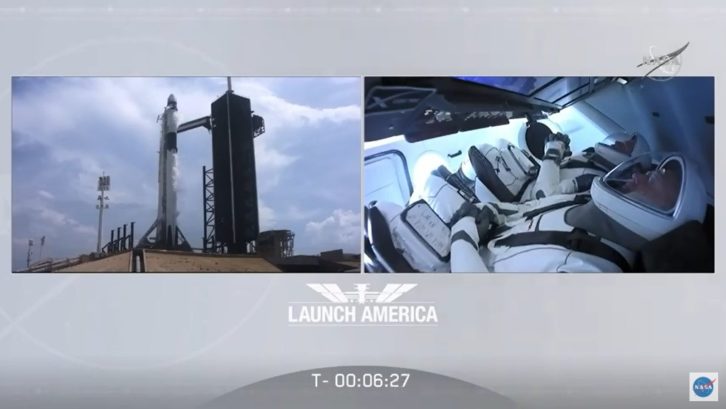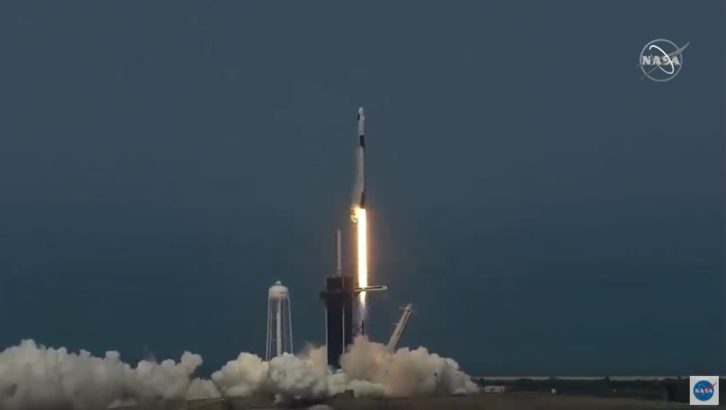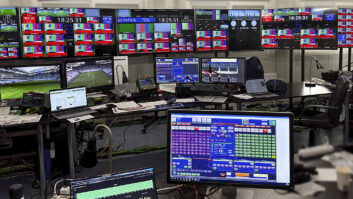On Saturday 30th May, millions of viewers around the world tuned in to watch the first launch into space from American soil in nine years.
As Crew Dragon prepared to launch from the iconic Complex 39A at Kennedy Space Center in Florida, a consortium of technology companies came together to make sure space fans could watch the launch live.
The Central Florida Media Committee, a consortium of media outlets created 10 years ago to produce pool coverage of major events, brought together a number of different technology solutions to beam pictures live from both inside the Crew Dragon cockpit and outside at various points around Kennedy Space Center. Among those companies are LiveU, Dejero and TVU Networks.
Of course, as the launch has drawn closer, the world has been in lockdown due to the coronavirus pandemic. The Committee significantly restricted the number of journalists allowed to cover the launch and also wanted to minimize the number of cameras at the Kennedy Space Center press site. “The commitee chose to employ TVU Grid as it’s designed to use IP to allow for the switching, routing and distribution of video camera sources from one location to any number of other locations over IP (which is the connection type being used for transmission in this event) with low latency and in broadcast quality video,” explains TVU Networks’ CEO Paul Shen. “For the NASA and SpaceX launch, a pool camera feed was set up that includes TVU Grid and was used by all media outlets globally for live video pool distribution.”

The TVU Grid software was installed on the TVU Transceiver hardware housed on-site at the NASA TV annex. The TVU Grid is an IP-based switching, routing and distribution solution for point to multipoint live video distribution, which Shen says is perfect for use in video pool feeds for sharing from a single location such as this to multiple locations anywhere in the world.
“Another reason TVU Grid has been chosen to help with this video broadcast is because of the large number of broadcasters globally that have deployed Grid as a part of their everyday broadcast workflow and so had immediate access to the NASA feeds,” adds Shen. “In addition, we have a process in place to help other media organisations interested in accessing the NASA feeds through TVU Grid.”
For Dejero, the launch was the first time the company had worked with NASA. It provided two Dejero PathWay encoders which were installed at the Kennedy Space Center and delivered the live feeds through its Cloud-based distribution solution, MultiPoint, to Dejero customers.
“The Dejero equipment was shipped to Florida, where the engineers there were able to rackmount the units. Once powered up, the Dejero team was able to remotely access the units to configure and route the live video,” says Yvonne Monterroso, director, Product Management. “As part of a wider collaborative broadcast solution during the launch, Dejero enabled encoding, transmission and video distribution to all Dejero customers, including local Florida station WJXT, a member of the media pool. They used two Dejero WayPoint receivers to reconstruct, decode and output feeds from the Dejero PathWay transmitters located at the Kennedy Space Center.”
NASA TV also installed a LU4000 4K/HEVC receiver to take in the feed from an LU600 HEVC unit which documented the astronauts’ trip from the holding area to the launch pad and subsequent launch. LiveU Matrix powered the worldwide distribution of multiple positioned pool cameras – provided by the Central Florida Media Committee all week leading up to the launch. LiveU encoders were also connected to cameras throughout Kennedy Space Center, which were fed to their receivers in their master control room. The content was made available in the Cloud on the LiveU Matrix platform for broadcasters to view and leverage locally for their newscasts.
While everyone was focused on whether the rocket could launch, particularly after the original flight was scrubbed on Wednesday night, it was also vitally important that the technology providing the TV pictures worked as well.

All three companies were closely monitoring the feeds, along with the consortium of media outlets. TVU Networks had technical personnel monitoring the NASA live feeds through TVU Grid during the testing period and also monitoring the feeds on the day of the launch. On-location station personnel managing the pool feed also set up a conference bridge with all vendors that was available before and during the launch.
According to Montessero, the Cloud infrastructure and supporting remote installations is something the Dejero team is very familiar with. Additionally, the NASA broadcasting team had someone on site that can help with any issues like a power cable getting knocked loose.
Shen says everyone at TVU Networks feels “honoured” to have been part of the historic launch, particularly as much of the lead-up to the event has been dominated by the on-going coronavirus pandemic. “Being able to participate in bringing this highly anticipated event to global media organisations is our way of helping to provide business continuity during this challenging time,” he says.
“Given social distancing measures, along with our general need to see some good news during these challenging times, Dejero is thrilled to have the opportunity to provide this content to our customers,” adds Monterosso. “It’s great to be part of this historical event.”
“Recently, the COVID-19 pandemic has required many press pools to be significantly reduced. By joining forces with LiveU, all local stations were able to share one feed and our respective news editing teams were able to easily see the event and push critical information and content to all platforms quickly and seamlessly,” concludes Allison McGinley, news director WKMG and RTDNA Region 13 Director. “LiveU Matrix allows each station to work together safely and efficiently to get results for its local audience, while respecting the events constraints and our competitive positions.”







